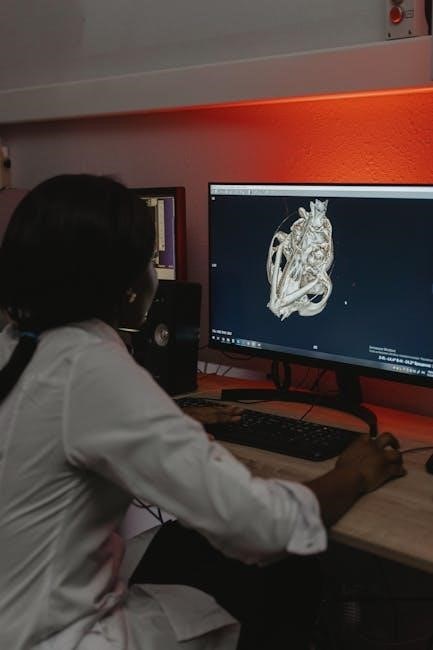The Lab Manual for Anatomy and Physiology provides a guide for learning with answers to questions and exercises found in the manual, making it a reliable resource for students and instructors alike always.
Overview of the Lab Manual
The lab manual for anatomy and physiology is a comprehensive resource that provides students with a thorough understanding of the human body and its functions. The manual is designed to be used in conjunction with a textbook and other course materials, and it includes a variety of activities and exercises to help students learn and retain the material. The lab manual is typically organized into units or chapters, each of which focuses on a specific aspect of anatomy and physiology, such as the skeletal system or the circulatory system. The manual includes detailed illustrations and diagrams to help students visualize the structures and processes being studied, as well as review questions and exercises to help reinforce learning and promote critical thinking. Overall, the lab manual is an essential tool for students studying anatomy and physiology. It provides a structured and interactive approach to learning.
Importance of the Solutions Manual
The solutions manual is a crucial component of the anatomy and physiology lab manual, providing answers to the questions and exercises found in the manual. This resource is essential for students, as it allows them to check their work and ensure they are understanding the material correctly. The solutions manual also helps instructors to grade assignments and provide feedback to students. By using the solutions manual, students can identify areas where they need to focus their studying, and instructors can tailor their teaching to meet the needs of their students. The solutions manual is an valuable tool for anyone studying anatomy and physiology, as it helps to promote learning and understanding of the subject matter. It is a key resource for achieving success in the course, and is highly recommended for all students. The manual is widely available online.

Features of the Laboratory Manual
The laboratory manual contains dynamic activities and experiments to help students visualize anatomical structures and understand physiological topics clearly always online.
Dynamic and Applied Activities
The laboratory manual features dynamic and applied activities designed to engage students in the learning process, helping them to visualize anatomical structures and understand complex physiological topics. These activities are carefully crafted to promote hands-on learning, encouraging students to apply theoretical knowledge in practical scenarios. By incorporating real-world examples and case studies, the manual provides a comprehensive learning experience that prepares students for future careers in the field. The activities are structured to foster critical thinking, problem-solving, and collaboration among students, making the learning process enjoyable and interactive. The manual’s emphasis on applied activities ensures that students develop a deep understanding of anatomical and physiological concepts, enabling them to make informed decisions and think critically in a variety of situations; Overall, the dynamic and applied activities in the laboratory manual are essential for creating a engaging and effective learning environment.
Lab Exercises and Information Application
The laboratory manual includes a range of lab exercises that require students to apply information and concepts learned in the classroom. These exercises are designed to help students develop critical thinking and problem-solving skills, as well as to promote a deeper understanding of anatomical and physiological concepts. By applying theoretical knowledge in practical scenarios, students can develop a more comprehensive understanding of the subject matter. The lab exercises are structured to encourage students to think critically and make informed decisions, preparing them for future careers in the field. The manual’s emphasis on information application ensures that students can retain and apply knowledge in a variety of situations, making it an essential resource for students and instructors alike. The exercises are carefully crafted to promote learning and understanding, and to help students achieve their academic goals. Effective learning is facilitated through these exercises.

Analysis of the Laboratory Manual
The manual is analyzed for its effectiveness in teaching anatomy and physiology concepts clearly always.
Pedagogical Merits of the Laboratory Manual
The laboratory manual has several pedagogical merits that make it an effective tool for teaching anatomy and physiology. The manual is designed to provide a comprehensive learning experience, with a range of activities and exercises that cater to different learning styles. The use of dynamic and applied activities helps students to visualize anatomical structures and understand complex physiological topics. The manual also includes lab exercises that require students to apply information and think critically, which helps to develop their problem-solving skills. Additionally, the manual provides opportunities for students to work in groups and collaborate with their peers, which helps to promote teamwork and communication skills. Overall, the laboratory manual is a valuable resource for students and instructors, and its pedagogical merits make it an essential tool for teaching anatomy and physiology. The manual is widely used and respected in the field of anatomy and physiology.
Utility of the Answer Key
The answer key is a valuable resource for students and instructors, providing answers to questions and exercises found in the laboratory manual. The answer key helps students to check their work and understand where they went wrong, which is essential for learning and improvement. It also saves instructors time and effort, as they can use the answer key to grade assignments and provide feedback to students. The answer key is also useful for students who are struggling with certain concepts, as it provides a clear and concise explanation of the correct answers. Overall, the utility of the answer key lies in its ability to provide accurate and reliable answers, which helps to promote student learning and understanding. The answer key is an essential tool for anyone using the laboratory manual, and its utility is undeniable. It is a valuable resource that enhances the learning experience.

Accessing the Answer Key

Students can access the answer key online through websites like Chegg.com or by purchasing a copy of the answer key book, making it easily accessible always online.
Online Resources
There are various online resources available for accessing the answer key, including websites like Chegg.com, where students can rent or buy the answer key for a discounted price. These websites provide instant access to the answer key, allowing students to quickly review and complete their lab assignments. Additionally, some websites offer free 7-day instant eTextbook access to the laboratory manual, giving students a chance to try out the resource before committing to a purchase. Online resources also include search engines and educational websites that provide links to downloadable answer keys or online forums where students can discuss and share answers to lab questions. Overall, online resources make it easy for students to access the answer key and complete their anatomy and physiology lab assignments with ease and convenience, making learning more efficient and effective for students everywhere always.
Alternative Sources
Alternative sources for accessing the answer key include used bookstores, library reserves, and student sharing. Some students may also find answer keys posted on online forums or social media groups. Additionally, some instructors may provide answer keys or study guides as supplemental materials for their courses. These alternative sources can be helpful for students who are unable to access the answer key through traditional means, such as those who are taking online courses or who do not have access to certain websites. By exploring these alternative sources, students can still access the answer key and complete their lab assignments, even if they are unable to find it through more conventional means, and can help to ensure their success in the course, and provide a more comprehensive learning experience for students everywhere.
The anatomy physiology lab manual answers are essential resources for students and instructors, providing valuable support and guidance always and everywhere online easily.
Importance of the Lab Manual and Answer Key
The lab manual and answer key are crucial components of anatomy and physiology education, providing students with a comprehensive understanding of the subject matter. The lab manual offers a range of exercises and activities that help students develop practical skills, while the answer key provides a valuable resource for checking work and understanding complex concepts. By using the lab manual and answer key together, students can gain a deeper understanding of anatomy and physiology, and develop the skills and knowledge needed to succeed in their studies. The importance of the lab manual and answer key cannot be overstated, as they provide a foundation for further learning and play a critical role in helping students achieve their academic goals. Overall, the lab manual and answer key are essential tools for anyone studying anatomy and physiology. They are highly recommended for students and instructors alike.
